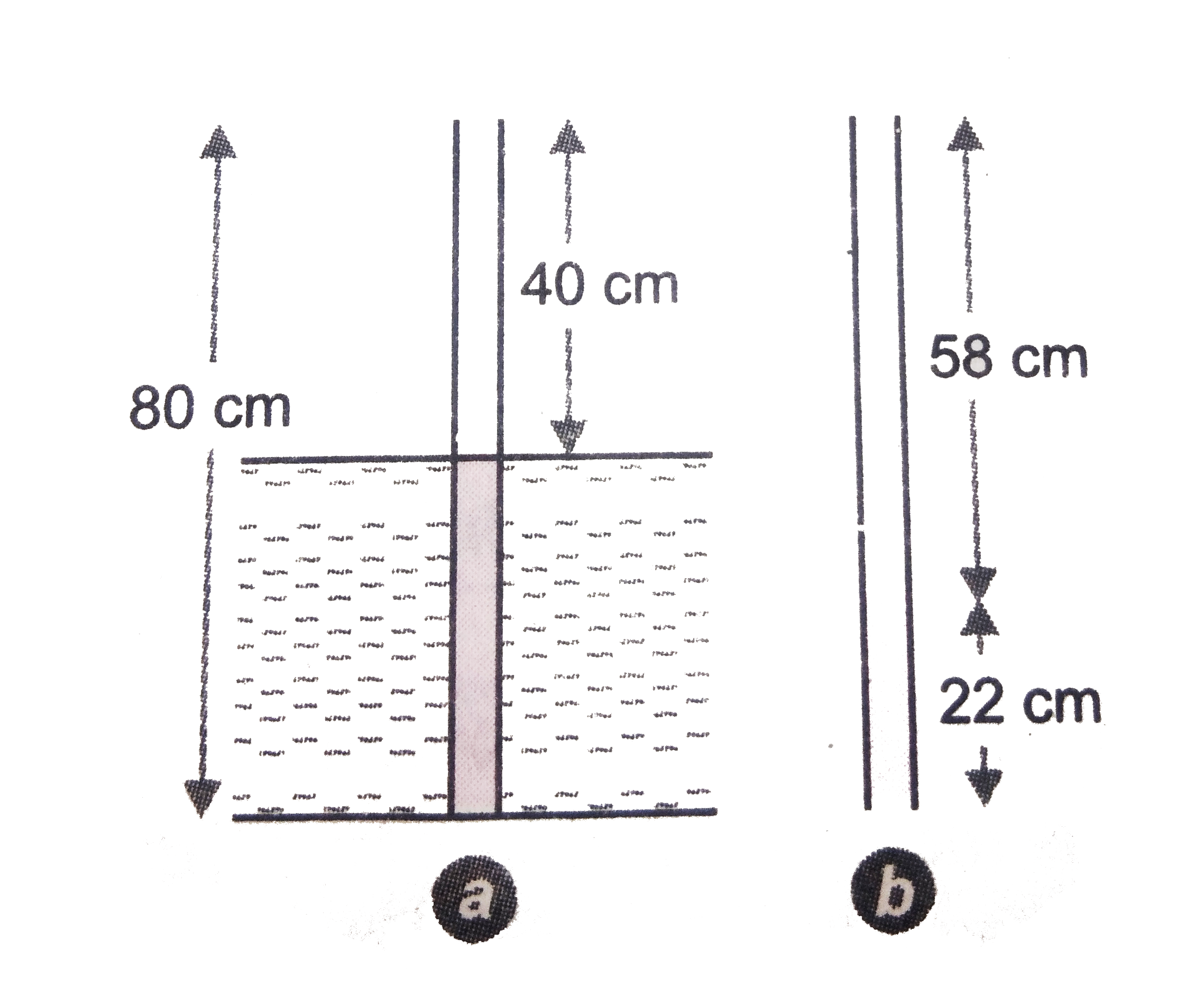Complete Solutions to CHAPTER 12 (KINETIC THEORY) of chapter CHAPTERWISE NUMERIC /INTEGER ANSWER QUESTIONS of Class 12 book with complete answers and questions
| Class 12 | PHYSICS |
| Chapter | CHAPTERWISE NUMERIC /INTEGER ANSWER QUESTIONS |
| DISHA PUBLICATION | CHAPTER 12 (KINETIC THEORY) |
| Number Of Questions | 15 |
| Academic Year | 2023-24 |
A mixture of 2 moles of helium gas (`(atomic mass)=4a.m.u`) and 1 mole of argon gas (`(atomic mass)=40a.m.u`) is kept at 300K in a container. The ratio of the rms speeds `((v_(rms)(helium))/((v_(rms)(argon))` is
View SolutionA mass M = 15 g of nitrogen is enclosed in a vessel at temperature T = 300 K. What amount of heat has to be transferred to the gas to increase the root-mean-square velocity of molecules 2 times ?
View SolutionHalf mole of an ideal monoatomic gas is heated at constant pressure of 1 atm from `20^(@)C " to " 90^(@)C`. Work done by gas is close to: (Gas constant R = 8.31 J/mol-K)
View SolutionAn ideal gas occupies a volume of `2m^(3)` at a pressure of `3xx10^(6)` p,a the energy of the gas is :
View SolutionAn ideal gas is enclosed in a cylinder at pressure of 2 atm and temperature, 300 K.The men time between two successive collosions is `6xx10^(-8)` s. If the pressure to `500K`, the mean time between two successive collisions will be close to :
View Solution`10^(22) ` particles each of mass `10^(-26) Kg` are striking perpendicular on a wall of area `1 m^(2)` with speed `10^(4)m//s` in `1 sec`. The pressure on the well if collision are perfectly elastic is : (A) `2 N//m^(2)` (B) `4N//m^(2)` (C) `6N//m^(2)` (D) `8 N//m^(2)`
View SolutionThe temperature, at which the root mean square velocity of hydrogen molecules equals their escape velocity from the earth, is closest to:
[Boltzmann constant ` k _ B = 1.38 xx 10 ^( -23) J//K ` Avogadro Number ` N _ A = 6.02 xx 10 ^( 26) // Kg ` Radius of Earth :
` 6.4 xx 10 ^( 6 ) ` m Gravitational acceleration on Earth ` = 10 ms ^( -2) ` ]
View SolutionFor a given gas at 1 atm pressure, rms speed of the molecules is 200 m/s at `127^(@)C`. At 2 atm pressure and at `227^(@)C`, the rms speed of the molecules will be:
View SolutionTwo different masses m and 3m of an ideal gas are heated separately in a vessel of constant volume, the pressure P and absolute temperature T, graph for these two cases are shown in the figure as A and B. The ratio of slopes of curves B to A is

View SolutionAn air bubble of volume `1.0 cm^(3)` rises from the bottom of a lake 40 m deep at a temperature of `12^(@) C`. To what volume does it grow when it reaches the surface, which is at a temperature of `35^(@) C`. ? Given `1 atm = 1.01 xx 10^(5) Pa`.
View SolutionTwo moles of helium gas is mixed with three moles of hydrogen molecules (taken to be rigid). The molar specific heat of mixture at constant volume is ______ `("in J//mol//K") ? ("R = 8.3 J//mol K")`
View SolutionA narrow uniform glass tube 80 cm long and open at both ends is half immersed in mercurry. Then the top of the tube is closed and it is taken out of mercury. A column of mercury 22 cm long then remains in the tube. What is the atmospheric pressure?

View SolutionA vessel of volume , `V = 5.0` litre contains `1.4 g` of nitrogen at a temperature `T = 1800 K`. Find the pressure of the gas if `30%` of its molecules are dissociated into atoms at this temperature.
View SolutionA gaseous mixture enclosed in a vessel consists of one gram mole of a gas A with `gamma=(5/3)` and some amount of gas B with `gamma=7/5` at a temperature T.
The gases A and B do not react with each other and are assumed to be ideal. Find the number of gram moles of the gas B if `gamma` for the gaseous mixture is `(19/13)`.
View SolutionAn oxygen cylinder of volume 30 litre has an initial gauge pressure of 15 atm and a temperature of `20^(@)C`. After some oxygen is withdrawn from the cylinder, the gauge pressure drops to 11 atm and its temperature drop to `17^(@)C`. Estimate the mass ( inkg) of oxygen taken out of the cylinder, `R=8.3J"mol"^(-1)K^(-1)`, molecule weight of oxygen =32.
View Solution
CHAPTER 12 (KINETIC THEORY) questions and complete solutions for chapter CHAPTERWISE NUMERIC /INTEGER ANSWER QUESTIONS of DISHA PUBLICATION PHYSICS (HINGLISH) of Class 12
All Exercises from DISHA PUBLICATION Class 12 PHYSICS CHAPTERWISE NUMERIC /INTEGER ANSWER QUESTIONS
- CHAPTER -10 (THERMAL PROPERTIES OF MATTER)
- CHAPTER -2 (Motion in a Straight Line)
- CHAPTER -21 : (ALTERNATING CURRENT)
- CHAPTER -25 : (DUAL NATURE OF RADIATION AND MATTER)
- CHAPTER -3 (MOTION IN PLANE)
- CHAPTER -4 (LAWS OF MOTION)
- CHAPTER -5 (WORK, ENERGY AND POWER)
- CHAPTER -7 (GRAVITATION)
- CHAPTER -7 (MECHANICAL PROPERTIES OF SOLIDS)
- CHAPTER 11 (THERMODYNAMICS)
- CHAPTER 12 (KINETIC THEORY)
- CHAPTER 13: (OSCILLATIONS)
- CHAPTER 14: (WAVES)
- CHAPTER 15 : (ELECTRIC CHARGES AND FIELDS)
- CHAPTER 16 : (ELECTROSTATIC POTENTIAL AND CAPACITANCE)
- CHAPTER 17 : (CURRENT ELECTRICITY)
- CHAPTER 18- (MOVING CHARGES AND MAGNETISM)
- CHAPTER 19 : (MAGNETISM AND MATTER)
- CHAPTER 20 : (ELECTROMAGNETIC INDUCTION)
- CHAPTER 22 : (ELECTROMAGNETIC WAVES)
- CHAPTER 23 : (RAY OPTICS AND OPTICAL INSTRUMENTS)
- CHAPTER 24 : (WAVE OPTICS)
- CHAPTER 26 : (ATOMS)
- CHAPTER 27 : (NUCLEI)
- CHAPTER 28 : (SEMICONDUCTOR ELECTRONICS; MATERIALS, DEVICES AND SIMPLE CIRCUITS)
- CHAPTER 29 : (COMMUNICATION SYSTEMS)
- CHAPTER 6 (SYSTEM OF PARTICLES AND ROTATIONAL MOTION)
- CHAPTER-1 (Physical World, Units and Measurements)
- CHAPTER-9 (MECHANICAL PROPERTIES OF FLUIDS)